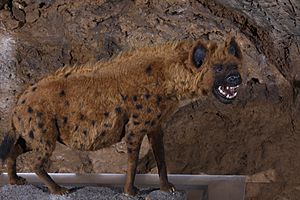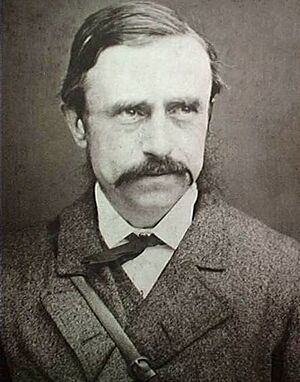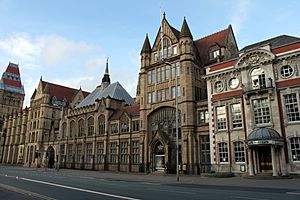William Boyd Dawkins facts for kids
Quick facts for kids
William Boyd Dawkins
|
|
|---|---|

William Boyd Dawkins
|
|
| Born | 26 December 1837 Buttington, Montgomeryshire, Wales
|
| Died | 15 January 1929 (aged 91) |
| Alma mater |
|
| Occupation | |
| Signature | |
Sir William Boyd Dawkins FRS FSA FGS (born December 26, 1837 – died January 15, 1929) was a famous British geologist and archaeologist. He worked for the Geological Survey of Great Britain. He was also the Curator of the Manchester Museum. Later, he became a Professor of Geology at Owens College in Manchester. He is well-known for his studies of fossils and early human history. He helped with big projects like a tunnel under the Humber River. He also worked on an attempt to build a Channel Tunnel and found coal under Kent.
Contents
Early Life and Education
William Boyd Dawkins was born in Wales on December 26, 1837. His birthplace was Buttington Vicarage in Montgomeryshire. When he was just five years old, he started collecting fossils. He found these fossils near local coal mines.
Soon after, his family moved to Fleetwood in Lancashire, England. He went to Rossall School there. He kept adding to his fossil collection, finding more from the local clay. After school, he went to Jesus College, Oxford University. He studied Classics and Natural Sciences, doing very well in both.
A Career in Geology
After finishing university in 1862, Dawkins joined the Geological Survey of Great Britain. He spent seven years exploring areas like Kent and the Thames Valley. In 1869, he became a member of the Geological Society. That same year, he became the Curator of the Manchester Museum. He held this important job until 1890.
In 1870, he also started teaching at Owens College in Manchester. By 1874, he became the first Professor of Geology there. He was also a leader in several important groups. These included the Manchester Geological and Mining Society. He was also president of the Lancashire and Cheshire Antiquarian Society. In 1867, he was made a Fellow of the Royal Society. This is a very high honor for scientists. He was knighted in 1919 for his great work in geology. Sir William Boyd Dawkins passed away in 1929 when he was 91 years old.
Discoveries in Archaeology

Dawkins made many important discoveries in archaeology. In 1859, he moved to Somerset to study. He heard that workers had found bones near Wookey Hole Caves. He then led excavations in a place called the hyena den. He also explored Aveline's Hole, naming it after his teacher.
His work showed that early humans lived in the Caves of the Mendip Hills. This was the first proof of Stone Age people there. He also spent a lot of time exploring Derbyshire. He worked at places like Creswell Crags and Windy Knoll.
At Windy Knoll, he found bones of amazing animals. These animals lived in England before the ice ages. He found bones from bison, cave hyena, cave bear, and a large cat. This cat might have been related to the sabre tooth tiger. Many of these ancient bones are now in museums in Buxton and Manchester.
Tunnel Projects and Coal Discoveries
In 1882, Sir William Boyd Dawkins became the official surveyor for the Channel Tunnel Committee. He studied the geology of the English and French coasts near Dover and Calais. However, the project was stopped because there wasn't enough money. He also helped with a plan to build a tunnel under the Humber River.
In 1886, a railway company asked him if his Channel Tunnel work showed any coal under Kent. Finding coal there would be a huge benefit for the company. In 1887, Dawkins and other geologists proved that coal did exist under the younger rock layers in Kent. This was a very important discovery for the region.
Helping Others
Sir William Boyd Dawkins cared a lot about workers' rights. He especially wanted to help people in the coal mining industry. He strongly pushed for better education for miners. He even gave a lot of his own money to support this cause.
He also gave money to the Manchester Museum. The museum wanted to build a new part. Dawkins donated £500, which was a very large sum at the time. Later in his life, he fought for people whose homes were damaged. Their houses were sinking because of salt mines near Northwich, Cheshire. He helped them get fair payments for the damage.
When he died in 1929, his wife gave his large library of books to the town of Buxton. These 400 books, along with other personal items, are now at the Buxton Museum and Art Gallery. They are kept in a special room named after him.



